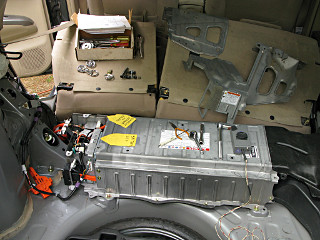
|
Since taking ownership of this 2004 model-year car in early 2005 I've never
had its battery box apart enough to actually see the NiMH modules, and
figured that after 130K on the clock maybe it was time to just give them a
quick eyeball. While there's never been a *problem* per se with this pack,
I have observed slightly higher voltage excursions in cold weather and odd
state-of-charge variations
at high altitude.
But more concerning is that there's always been a strange chemical smell
near the vent duct next to the rear seat, making me wonder if any sort of
leakage was happening. While I already know that the potassium hydroxide
electrolyte is nearly odorless itself, I feared that if any of it was
exposed to other materials it might be causing corrosion. Thus, time
to finally have a looksee in there to at least know what, if
anything, is going on.
I also wanted to take a look at the battery blower fan and related gack, thinking to implement a switch to run it at full speed on demand. I've already got one hacked in for the main radiator fans, which help push heat out of the underhood area even when coolant isn't circulating. After a warm day of travel, the battery pack also seems to retain quite a bit of heat under the floor panel which then drifts up into my bedding for half the night thereafter, so I wanted to see if I can exhaust all that out at least back to ambient before tucking in for the night. |

|
It was funny to dig back into this area and find that I'd left the old paper labels taped in from the "Naked" exhibit five years prior, from the first year I'd gotten the car. I probably figured I'd be doing the same kind of partial teardown and exhibit really soon thereafter. That investigation only went as far as the ECU and relay end of the battery box; never into the battery itself and I had never taken off the back-hatch trim panels over the vent and fan assembly side of things. This time it's all going to come out, although the battery box *itself* doesn't need to be removed from the car. In fact, the intent is to leave it in and bring it live again for some additional experimentation. |
|
There's not much need for excruciating detail about battery-box or rear
interior panel disassembly here. It's a bunch of bolts in obvious places.
The rear seat cushion needs to pop out to expose access to some of them, and
later in the exploratory process it helps to unbolt the seat backs themselves
and get them out of the way too. All that is easy, requiring nothing more
than your favorite 10/12/14 mm socket set.
And common sense about electrical safety, of course. The battery *can* be lethal if mishandled, just like any other high-voltage electricity source. |
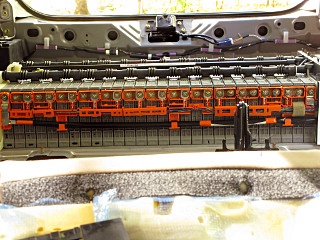
|
And about the same deal on the front side. So that immediately shoots down any suspicion that the smell might be coming from bad things happening in the battery box. That's a bit of a relief. |
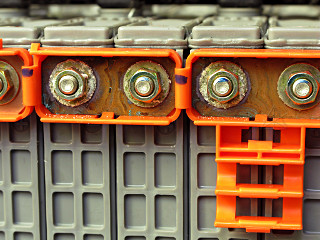
|
There is, however, just a little white "fuzz" on many of the terminal connections, mostly at the negative ones. Not sure why, but bears some deeper investigation. |
|
I did indeed get back in here for inspection, *another* six years on after
this adventure, and not only did said cleanup but also changed over to a
completely different set of interconnect straps. Read about it here. |
| Now, the safety-astute might view this procedure with horror -- a metal wrench handle, bare hand, and right onto a battery connection. Without my 1000-volt gloves on. Why am I not an instant crispy critter, accompanied by that cartoon "fzzZZZvvvZZZT" sound? |

|
|
Okay, let's stop and think rationally about this for a moment. 220 volts,
the nominal real-life running voltage of the pack, is on par with ordinary
household wiring which electricians work on every day without gloves. They
know how to not be stupid about it, know what's safe to touch and what
isn't and when, and how to make things safe for themselves as needed. One
difference is that where household wiring is AC and contains zero-crossings,
this is DC and at least until relatively recently, was popularly considered
to have more of a tendency to lock up muscles at relatively modest levels
of current through the body. [This is still being researched and worked
into safety standards; see
this paper
and some of the ongoing work at
EFCOG
for more. It's kind of hard to engage human volunteers to help nail
these things down...]
But the key concept for any hazard is that one needs to complete a circuit. With the car powered off and the battery-box relays open, there is no connection between the battery and the outside world and least of all the car body since the whole hybrid HV system runs isolated anyway. The only available high voltage along the battery pack would come from grabbing terminals at *two* places, at a fairly wide separation. Each module pair presents about 16V between the straps where the serpentine turns around, so the voltage hazard would step up by about 16V per hop as the second point of contact moves down the pack. Obviously one doesn't want to short-circuit any of this as the high current capability could rapidly heat anything metal and cause arc flash and fires, but without substantial separation the current likely to pass through typical skin resistance is quite low. But skin resistance can vary quite a bit depending on moisture and contact area. Some people would have issues with a 24V doorbell transformer. My fingertips tend to be fairly dry, and I routinely test for 120V household voltage by poking across the terminals and feeling a little buzz. Unless I'm grounded in some other way, like working barefoot on a damp concrete floor [been there done that], it's safe enough as long as the touch is with the correct part of the fingers and the available voltage is known. It's a little more entertaining if I'm sweating, and I hesitate to test 240V this way as it's a bit too much tingle unless my fingers are *very* dry at the time, but I have on occasion. So how much of a Prius battery is safe for the "human voltmeter" test? Well, I can cheat a little on this determination: I have a variable DC bench supply that goes to about 500 volts but fairly low current output and using that, I have my "two-finger the alligator clips" test up around 150V before approaching anything like a pain/discomfort level. That's at about one milliamp, where five or so is considered dangerous and for the most part only if taking a path across the heart. Now let's go back outside and play. |

|
These block voltages can be queried and displayed with a suitable scantool, in this case my slightly out of date version of AutoEnginuity with the Toyota manufacturer-specific enhanced diagnostics enabled and conversing directly with the battery ECU. Watching these during various charge/discharge load tests can help isolate a failing module if any exist -- it would be one of the pair whose block voltage swings more than the others on current-flow changes. Of course the battery ECU itself looks for such anomalies and sends up "battery block N grows weak" error codes if things get too out of whack. Which, I'll add, is an *extraordinarily* rare occurrence in a second-generation Prius to date. |
| As does this, albeit taken from the third-gen Prius documentation where they actually explain it a little better than in the '04 manual. The "high voltage load" is everything else in the car with the scary orange wires. |
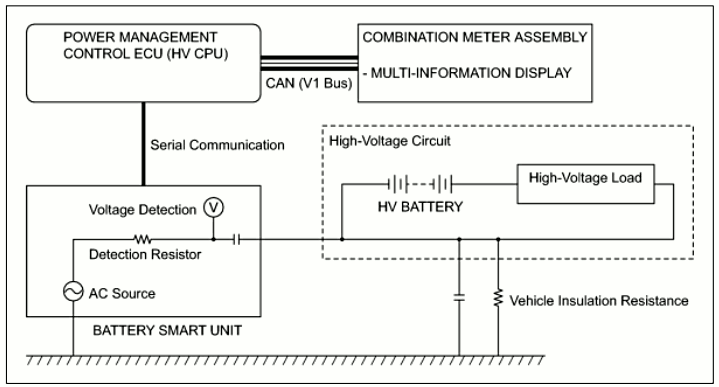
|
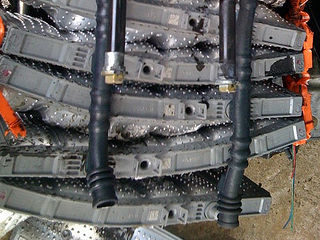
|
It's not clear that these tubes *ever* pass any gas coming from
the batteries. In the experience of everyone I know who has overcharged
these modules, the vents never actually vent. Instead, pressure builds
up inside the cases and they bulge out at the sides, puffing like chipmunk
cheeks if things get bad enough, and can force their way right out of a fairly
strong battery enclosure from the combined pressure and bend themselves
into useless crap in the process. You would think that the vents would let
go to relieve the overcharge pressure long before the point of destruction,
but I don't think *anyone* has ever observed them actually doing so.
As tempting as it is to leave the silly tubes off entirely, I put them back in so they can continue stinking up the seat vent. At least now I know what the deal is.
[picture credit: aminorjourney @ priuschat's PHEV thread -- a fascinating tale!] |
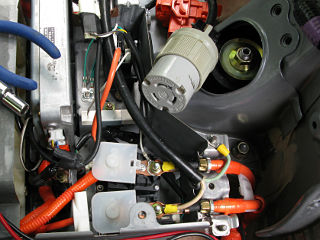
|
During reassembly, I've decided to add a main battery tap. Post-relay,
where it belongs -- none of this BS about sneaking around behind the current
sensor. If I ever build some kind of PHEV rig to inject extra juice into
the system, the car is bloody well going to know about it and keep track
of its own real SOC. I've decided to use a typical L5-20 plug and run
through the two larger size blades which are normally neutral and ground.
I don't expect to ever want to push more than 20A into or out of the system;
any proposed current injection via a PHEV lashup would only be a gentle
"SOC helper" like the
Enginer system.
More likely would be a heftier inverter or UPS whose native battery voltage
is around 220V in the first place. That would yield about 4 kW, enough to
power most things around a home or many types of remote event.
A short 12/3 cable runs out one of the few non-sharp-edged case holes and the twistlock receptacle tucks neatly into the corner by the suspension tower and safety plug for whenever I decide to actually do something with it. While the green wire of the cable runs to the case at one end, it doesn't emerge into the receptacle at all for now. |
|
I think that in slightly different ways, both the Hymotion and Enginer people
have substantially proven that using a proper regulator to send controlled
currents into the Prius HV system while letting the car's current sensor
see it is the correct way to go and doesn't cause the error conditions that
the frankly bumbling contactor-based PHEV systems do if they connect at the
same points. While the early experimenters assumed that it was due to
battery/motor current mismatches double-checked by various ECUs, it is fairly
clear by now that instead it's all because of uncontrolled cross-currents
between packs and high spikes at the moment of relay connection. Regulated
systems don't have this problem. Read between the lines in the early
CalCars experiments
and it becomes pretty obvious that they, and all who have followed in their
footsteps, were going at it in a really ham-handed manner doomed to fail.
Especially with mixed battery chemistries involved. *Shiver*.
Fan investigation One concept kicked around among the tech community has been a battery warmer to bring the pack closer to its optimum performance temperature on cold days. When it's too cold you can't get into EV mode, your regen is limited to 40 or 50 amps, and in general the pack just isn't happy until it warms up a little via a combination of self-heating and warmer cabin air requested by the driver. At some point I noodled the idea of using one of those flexible rubber heating elements under the thing, but with the box apart I now see that the lower inch and a half worth of height is all air duct and heating under that probably wouldn't do much good. And trying to directly heat under the modules would block all the airflow! So if any sort of pack heater were to be done, the right place might be a PTC heater in the duct airflow and a way to run the fan to push the warm air in. Except that in this setup, airflow through the pack is *downward* for some inexplicable anti-convection reason and would probably work even less well than expected. Still, it's another potential reason to want to run the battery fan, so let's have a closer look at all that stuff. While I don't know the exact wiring changes done, I know that one or two of the PHEV kits out there include parts to rewire some of the related stuff and run the fan motor full speed on demand. I think it's usually a klunky setup with relays to just swap the fan leads over to fixed power, but having noodled out the variable-speed fan controller for the climate blower I assume the same concept should map to an elegant solution for this one. |
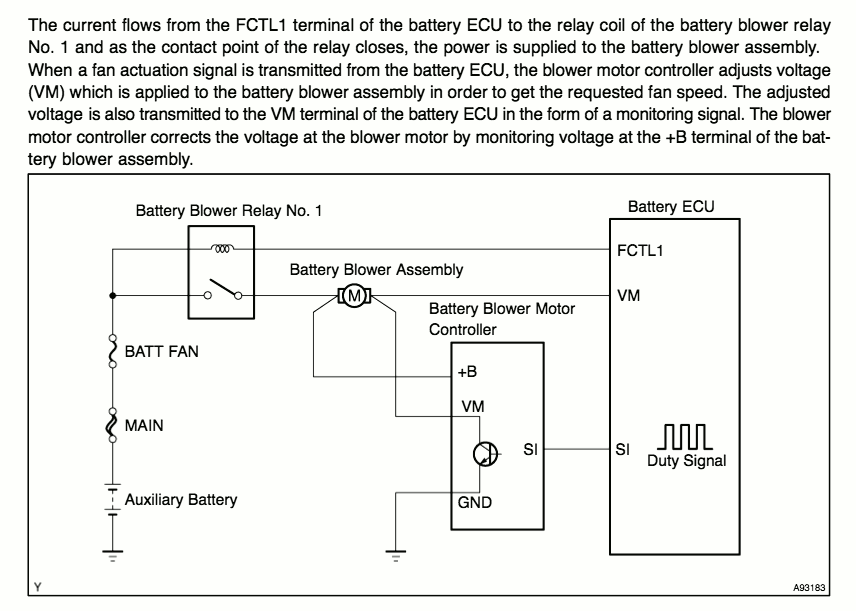
Here's how the control setup works: the blower system is commanded on by enabling FCTL1 to bring power to the fan and controller, and then the battery ECU provides negative-going PWM to regulate the speed. There's a problem, though: the battery ECU also *checks* how fast the fan is running by monitoring the switched-lead voltage at VM. |

|
Finally it's time to reassemble everything, taking the opportunity to get
a smidge of anti-seize onto all the bolt threads.
This captive nut for the luggage D-ring lost its spot-welds to the battery box suspension-tower brace. Maybe this cracked off from using the ring to strap in the big UPS. Nothing a little tape can't fix; it only has to hold long enough to get the panel on and the bolt threaded in. |